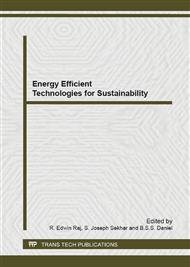[1]
R. Saidur, M.T. Sambandam, M. Hasanuzzaman, D. Devaraj, S. Rajakarunakaran, M.D. Islam, An energy flow analysis in a paper-based industry, Clean Technology & Environment Policy, 1 (2010) 462-469.
DOI: 10.1007/s10098-012-0462-9
Google Scholar
[2]
P. Loganthurai, S. Parthasarathy, S. Selvakumaran, V. Raja sekaran, Energy conservation measures in technical institutional building in Tamilnadu in India, Energy Procedia, 14(2011) 1181-1186.
DOI: 10.1016/j.egypro.2011.12.1073
Google Scholar
[3]
R. Saidur, S. Mekhilef, Energy use, energy savings and emission analysis in the Malaysian rubber producing industries, Applied Energy, 87(2010) 2746-58.
DOI: 10.1016/j.apenergy.2009.12.018
Google Scholar
[4]
Malkiat Singh, Gurpreet Singh, Harmandeep Singh, Energy audit: a case study to reduce lighting cost, Asian Journal of Computer Science and Information Technology, 2 (2012) 119 – 122.
Google Scholar
[5]
Muhammad Furqan Khurshid, Muhammad Asad, Atif Ali Khan, Muhammad Ashraf Chaudhry, Ammanullah, Investigation of specific energy consumption and possible reduction measures of textile spinning mills, Journal of American Science, 8 (2012) 535-542.
Google Scholar
[6]
R. Nilesh, Kumbhar, Rahul R. Joshi, An industrial energy audit: Basic approach, Modern Engineering Research, 2 (2012) 313-315.
Google Scholar
[7]
Bureau of energy efficiency (BEE), Energy efficiency in electrical utilities, Govt. of India, (2011).
Google Scholar
[8]
N. Ghaddar , T. Mezher, Modeling of current and future energy intensity and greenhouse gas emissions of the Lebanese industrial sector: assessment of mitigation options, Applied Energy, 63 (1999) 53–74.
DOI: 10.1016/s0306-2619(99)00018-5
Google Scholar
[9]
M.T. Sambandam, D. Devaraj, S. Rajakarunakaran , Energy audit- a tool to mitigate energy related CO2 emission in process industries, International conference on "Climate change and CO2 management: mitigation, separation and utilization, conducted at Anna University, Chennai, Tamilnadu, India, (2012).
Google Scholar
[10]
K. Chandran and P. Muthukumaraswamy, SITRA Energy audit–Implementation strategy in textile mills, The south India textile research association, Coimbatore, (2002).
Google Scholar
[11]
Information on http: /www. cea. nic. in/reports/planning/cdm_co2/user_guide_ver6. pdf CO2 baseline database for the Indian power sector, user guide version 6. 0. Central Electricity Authority (CEA), Government of India, (2011).
Google Scholar
[12]
Information on http: /www. retsnepal. org/pdf/karnali_ujyalo%20. pdf.
Google Scholar


